|
|
|
Sort Order |
|
|
|
Items / Page
|
|
|
|
|
|
|
| Srl | Item |
| 1 |
ID:
124519
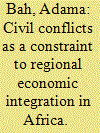

|
|
|
|
|
| Publication |
2013.
|
| Summary/Abstract |
Regional economic integration is crucial for African countries, notably since they are characterized by small domestic markets. In this paper, we analyze how civil conflicts affect the economic fate of regional economic communities through its effect on the synchronicity of regional partners' economies. We find that conflict decreases business cycle synchronicity when it occurs within a regional economic community, both for the directly affected countries and for their more peaceful regional peers. We therefore find an additional reason to recommend putting prevention and resolution of civil conflicts on the top of the political agenda of African RECs.
|
|
|
|
|
|
|
|
|
|
|
|
|
|
|
|
| 2 |
ID:
124520
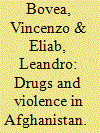

|
|
|
|
|
| Publication |
2013.
|
| Summary/Abstract |
This paper addresses the relationship between the level of violence and the opium market in Afghanistan's provinces. We first provide an overview of the nature and extent of the Afghan drug trafficking. This is followed by a vector autoregressive analysis of the nexus opium-insurgency activities using monthly time-series data on opium prices and the number of security incidents for 15 Afghan provinces over the period 2004-2009. We use a multifactor error structure, the common correlated effect, to include unobservable common factors; Impulse Response functions to describe the time path of the dependent variables in response to shocks; and the mean group estimator to summarize our results across the provinces. Results suggest a conflict-induced reduction in opium prices, while the reverse opium-violence mechanism is mostly negligible. Moreover, unobservable common factors are the main drivers of opium prices and violence.
|
|
|
|
|
|
|
|
|
|
|
|
|
|
|
|
| 3 |
ID:
124517
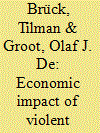

|
|
|
|
|
| Publication |
2013.
|
| Summary/Abstract |
Much of the work published in Defence and Peace Economics (DPE) significantly contributes to our understanding of the economics of conflict. Analyzing the second decade of its existence, Arce and Kollias (2010) showed that over time, the emphasis of work in DPE has shifted significantly. One rising field examines the consequences of conflict. Related to this, in 2011, DIW Berlin hosted a conference examining The Economic Impact of Violent Conflict. This special issue is the result of that conference. While this may seem like a relatively narrow area, the interpretation of that simple combination of words can be quite broad. Some of the core work in the area focuses on the calculation of the global impact of conflict (Collier, 1999, Hess, 2003, Brück, De Groot, and Bozzoli, 2012). The work of Collier (1999) has had the greatest impact and continues to do so. He focuses only on civil conflicts because of the perceived economic strengthening effects of international conflict. Collier argues that civil conflict affects growth through (i) the destruction of resources; (ii) the disruption of infrastructure and social order; (iii)
budgetary substitution; (iv) dissaving; and (v) portfolio substitution by foreign investors.
The first four of these channels are expected to influence an economy only during conflict, whereas the final one is likely to continue having a lasting effect even after the restoration of peace. This led Collier to come to his theory that the length of the conflict is going to influence the impact of the post conflict period. In particular, he argues that long-running conflicts are more likely to be followed by an increase in growth, whereas short-lasting conflicts will suffer reduced growth rates over a longer period of time (known as a legacy effect).
|
|
|
|
|
|
|
|
|
|
|
|
|
|
|
|
| 4 |
ID:
124518
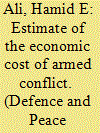

|
|
|
|
|
| Publication |
2013.
|
| Summary/Abstract |
There has been much debate in many forums to seek a settlement of the Darfur conflict (DC), but no study has addressed its economic cost. This study is the first attempt to quantify the economic cost of the DC. The war's costs include the destruction of infrastructure, direct military spending attributable to the war effort, and the impact of the latter on capital formation. In addition, the human destruction - loss of life and income - must be taken into account. Our calculations show that the government of Sudan has incurred costs totaling US$30.5 billion, equivalent to 171% of 2003 Gross Domestic Product GDP, on the war in Darfur. This includes $10.1 billion in direct military expenses; $7.2 billion in the lost productivity of internally displaces persons; $2.6 billion in foregone lifetime earnings of the dead; $4.1 billion in infrastructure damage; and $6.5 billion in war impacts on GDP. The total costs of the war are $41.5 billion if we added military spillover and African Union/UN hybrid operation in Darfur peace-keeping operations of $10.9 billion. While the country has spent only 1.3% of its budget on public health and less than 1% on education over the past two decades. The war consumes 13% of GDP in a society that lacks the means to provide the basic entitlements of education, food, health care, and shelter to its people.
|
|
|
|
|
|
|
|
|
|
|
|
|
|
|
|
| 5 |
ID:
124521
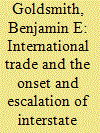

|
|
|
|
|
| Publication |
2013.
|
| Summary/Abstract |
Although study of the relationship between international trade and militarized conflict has become more sophisticated, whether trade reduces the chance of conflict, exacerbates it, or has no effect, remains contested. Integrating expectations from schools of thought often portrayed as incompatible, I consider two aspects of trade - volume and interdependence - and model conflict as a two-stage process involving onset and escalation. This perspective leads to robust statistical findings that trade is Janus-faced, both facilitating and inhibiting conflict at different stages, supporting the conclusion that a focus on international conflict as a communication process promises better theory in international relations.
|
|
|
|
|
|
|
|
|
|
|
|
|
|
|
|
|
|
|
|
|